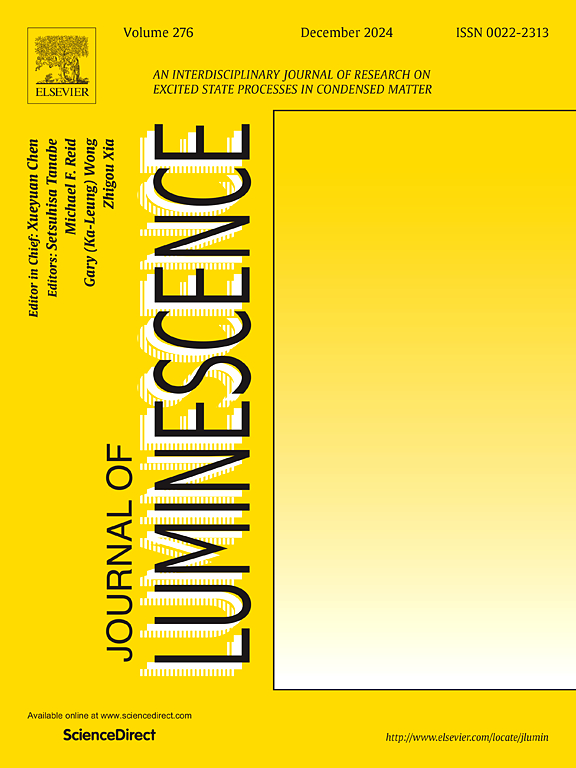Enhancement of gamma radiation sensitivity in tungsten-doped indium oxide thin films
IF 3.3
3区 物理与天体物理
Q2 OPTICS
引用次数: 0
Abstract
This paper reports on enhancement of gamma sensitivity in indium oxide doped with tungsten. Using the spray pyrolysis process, the thin films are deposited on a heated glass substrate. Gamma doses ranging from 25, 50, 100 and 200 Gy were utilized. According to XRD analysis, the films showed a single-phase and polycrystalline cubic structure with (400) preferred orientation. FESEM was used to conduct morphological studies. The cubic crystalline structure of the deposits is further supported by the micro-Raman measurement. After irradiation, it was discovered that the optical bandgap shrank. The dominant process of defect generation is responsible for the rise in the photoluminescence peak intensities following gamma exposure. The irradiated film was studied for thermoluminescence and deconvolution of the experimental glow curve indicated the emergence of a new peak corresponding to the dopant along with the primary peak around 230 °C. The elements contained in the sample are identified using XPS. The oxygen vacancies produced during gamma exposure determine the structural, optical, and electrical characteristics. The estimated sensitivities for applied voltages ranging from 1 V to 5 V fall within the range of 92.3–467.9 mA/cm2/Gy, exceeding both pristine and previously reported values.
钨掺杂氧化铟薄膜γ辐射敏感性的增强
本文报道了钨掺杂氧化铟中伽马灵敏度的增强。采用喷雾热解工艺,将薄膜沉积在加热的玻璃基板上。所使用的伽马剂量范围为25、50、100和200戈瑞。XRD分析表明,薄膜呈(400)择优取向的单相多晶立方结构。FESEM进行形态学研究。微拉曼测量进一步支持了镀层的立方晶体结构。辐照后,发现光学带隙缩小。缺陷产生的主要过程是伽马暴露后光致发光峰强度上升的原因。对辐照膜进行了热释光研究,实验发光曲线的反褶积表明,在230℃左右,随着原峰的出现,出现了一个与掺杂剂对应的新峰。样品中所含的元素用XPS进行了鉴定。在伽马暴露过程中产生的氧空位决定了结构、光学和电学特性。在1 V至5 V的电压范围内,估计灵敏度在92.3-467.9 mA/cm2/Gy之间,超过了原始值和先前报告的值。
本文章由计算机程序翻译,如有差异,请以英文原文为准。
求助全文
约1分钟内获得全文
求助全文
来源期刊

Journal of Luminescence
物理-光学
CiteScore
6.70
自引率
13.90%
发文量
850
审稿时长
3.8 months
期刊介绍:
The purpose of the Journal of Luminescence is to provide a means of communication between scientists in different disciplines who share a common interest in the electronic excited states of molecular, ionic and covalent systems, whether crystalline, amorphous, or liquid.
We invite original papers and reviews on such subjects as: exciton and polariton dynamics, dynamics of localized excited states, energy and charge transport in ordered and disordered systems, radiative and non-radiative recombination, relaxation processes, vibronic interactions in electronic excited states, photochemistry in condensed systems, excited state resonance, double resonance, spin dynamics, selective excitation spectroscopy, hole burning, coherent processes in excited states, (e.g. coherent optical transients, photon echoes, transient gratings), multiphoton processes, optical bistability, photochromism, and new techniques for the study of excited states. This list is not intended to be exhaustive. Papers in the traditional areas of optical spectroscopy (absorption, MCD, luminescence, Raman scattering) are welcome. Papers on applications (phosphors, scintillators, electro- and cathodo-luminescence, radiography, bioimaging, solar energy, energy conversion, etc.) are also welcome if they present results of scientific, rather than only technological interest. However, papers containing purely theoretical results, not related to phenomena in the excited states, as well as papers using luminescence spectroscopy to perform routine analytical chemistry or biochemistry procedures, are outside the scope of the journal. Some exceptions will be possible at the discretion of the editors.
 求助内容:
求助内容: 应助结果提醒方式:
应助结果提醒方式:


